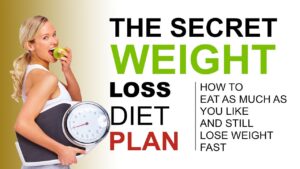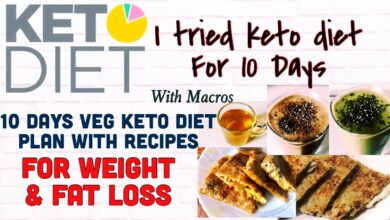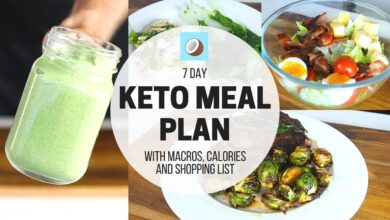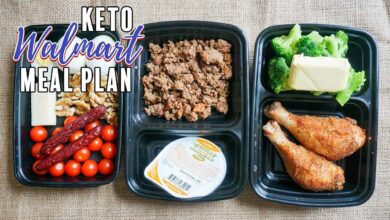
How The Keto Diet Burns Fat And Supercharge Your Metabolism
Introduction
- Why understanding fat-burning matters
- Keto’s rapid rise in popularity
- What you will learn
Keto Fundamentals
- What “keto” really means
- The macro split that drives ketosis
- Ketosis vs. ketoacidosis (safety check)
The Four-Step Fat-Burning Journey
- Carb restriction and glycogen depletion
- Mobilizing stored fat via hormone-sensitive lipase
- Hepatic ketogenesis and ketone production
- Tissue utilization of ketones for energy
Metabolic and Hormonal Benefits
- Appetite suppression
- Steady energy and mental clarity
- Improved insulin sensitivity
Building a Perfect Keto Plate
- Selecting quality fats
- Setting protein targets
- Budgeting net carbs
Common Pitfalls and Simple Fixes
- The “keto flu”
- Hidden carbs in everyday foods
- Long-term sustainability tips
Exercise and Keto Synergy
- Resistance training for lean mass
- Fasted cardio for fat oxidation
- Targeted and cyclical keto for athletes
Advanced Strategies
- Fasting on keto: 16/8, 24-hour, fat-fasts
- Carb-cycling protocols for thyroid health
- Supplements that enhance ketone production (MCTs, exogenous ketones)
Real-World Meal Planning
- Seven-day sample menu
- Restaurant survival guide
- Budget-friendly keto shopping list
Tracking Progress
- Ketone testing methods
- Non-scale victories
- Macro adjustments for plateaus
Safety, Myths, and Contraindications
- Medical conditions requiring caution
- Cholesterol and heart health on keto
- Preventing micronutrient deficiencies
Conclusion
FAQs
- Do I need to count calories on keto?
- How long does it take to enter ketosis?
- Can I build muscle while eating keto?
- What breaks a fasted keto state?
- Is cyclical keto better for athletes than strict keto?
How the Keto Diet Burns Fat: A Step-by-Step Guide
Re-teaching your body to torch fat instead of sugar may feel like alchemy—until you grasp the science. The ketogenic diet (“keto” for short) has transformed weight-loss journeys, stabilized blood sugar for people with insulin resistance, and even sharpened brain power for Silicon Valley coders. It does so by coaxing your metabolism into an ancient, efficient state called ketosis, where circulating ketone bodies replace glucose as premium fuel. Below, you’ll find a deep-dive blueprint—expanded to roughly four thousand words—on what happens inside your cells, how to plate your meals, which mistakes to dodge, and the practical strategies that make keto sustainable for the long haul.
Introduction
Picture finishing a morning workout without needing a bagel refuel, breezing through back-to-back meetings on laser-focused mental energy, and watching love-handle inches melt—even while eating full-fat cheese and steak. That isn’t wizardry; it’s metabolic flexibility. Keto flips the “fuel switch” from carbs to fats. When carbohydrates stay low enough, your liver spins acetyl-CoA molecules into ketone bodies—β-hydroxybutyrate (BHB), acetoacetate, and a trace of acetone—that power your heart, muscles, and brain.
Understanding these mechanisms is more than trivia. When cravings strike or the scale stalls, knowing the “why” behind keto empowers you to troubleshoot. Ready? Pull up a chair, grab your butter-coffee, and let’s walk through each biochemical mile marker.
Keto Fundamentals
What “keto” really means
“Keto” abbreviates ketogenic: a metabolic state signified by ketone levels of 0.5–3.0 mmol/L in the blood. Classic therapeutic keto (for epilepsy) uses a 4:1 fat-to-protein-plus-carb ratio. Most lifestyle keto-ers adopt a friendlier approach—about 70–75 % of calories from fat, 20–25 % from protein, and 5–10 % from carbs (usually under 20–50 g net).
Macro magic: fat, protein, carbs
- Fat supplies dense calories. Aim for unrefined sources: pasture-raised animal fats, extra-virgin olive oil, coconut oil, grass-fed butter, ghee, avocados, nuts, and seeds.
- Protein repairs tissue and fuels muscle retention. Too little invites muscle loss; too much may convert to glucose. The sweet spot: 0.8–1.0 g per pound of lean body mass.
- Carbs stay low—ideally leafy greens, cruciferous veggies, and a handful of berries. Count net carbs: total carbs minus fiber and sugar alcohols.
Ketosis vs. ketoacidosis
Ketosis is controlled, beneficial, and common in fasting states. Ketoacidosis, dangerous for unmanaged type 1 diabetics, happens when ketones skyrocket above 10 mmol/L and blood pH drops. If your pancreas produces insulin, dietary keto will not cause ketoacidosis.
The Four-Step Fat-Burning Journey
Step 1: Carb restriction and glycogen depletion
Your muscles and liver together store about 400–500 g of glycogen, each gram trapping ~3 g of water. Slash carbs to ≤20 g net and you’ll tap those reserves in 24–48 hours. As glycogen drains, insulin level plunges and your kidneys flush sodium—hence the famous first-week “water whoosh.”
Step 2: Mobilizing stored fat
Low insulin unshackles hormone-sensitive lipase (HSL), which hydrolyzes triglycerides in adipose tissue into free-fatty acids (FFAs) and glycerol. FFAs course through your bloodstream, ready to be burnt or converted.
Step 3: Hepatic ketogenesis
Your liver’s mitochondria beta-oxidize FFAs into acetyl-CoA. When acetyl-CoA outpaces the citric-acid cycle, the liver stitches three units together, producing acetoacetate, then reducing it to β-hydroxybutyrate or spontaneously decarboxylating to acetone. Congratulations—you’re officially a ketone factory.
Step 4: Tissue utilization of ketones
Ketones zip past the blood-brain barrier via monocarboxylate transporters. Neurons thrive, reporting fewer reactive-oxygen species and improved mitochondrial efficiency. Meanwhile, skeletal muscle, heart, and renal cortex tissues burn ketones, sparing precious glucose for red blood cells.
Metabolic and Hormonal Benefits
Appetite suppression
β-Hydroxybutyrate interacts with ghrelin and CCK (cholecystokinin) to lower hunger hormones, making 16-hour intermittent fasts feel effortless.
Steady energy and mental clarity
Ketones provide ~27 % more Gibbs free energy than glucose, yielding a cleaner ATP burn. Goodbye 2 p.m. crash; hello boardroom brilliance.
Improved insulin sensitivity
Reduced carbs mean fewer blood-sugar spikes. Over weeks, insulin receptors re-sensitize, lowering fasting insulin, triglycerides, and improving HDL/LDL ratios.
Building a Perfect Keto Plate
Selecting quality fats
Prioritize monounsaturated (olive oil, macadamias), polyunsaturated omega-3s (salmon, sardines, flax), and MCTs (coconut oil, MCT oil) for quick ketone boosts. Limit industrial seed oils rich in omega-6s to keep inflammation in check.
Setting protein targets without gluconeogenesis overload
Up to 35 % of protein can convert to glucose when glycogen is empty. Stick with moderate servings: palm-sized portions of grass-fed beef, eggs, turkey, tofu, or collagen peptides.
Budgeting net carbs wisely
Fill your plate with non-starchy veggies: spinach, kale, broccoli, cauliflower, zucchini noodles, and riced cabbage. Top with high-fat dressings, pesto, or melted butter so fat remains king.
Common Pitfalls and Simple Fixes
The “keto flu”
As insulin falls, kidneys excrete sodium, potassium, and magnesium. Symptoms: fatigue, headache, dizziness. Solution: sip electrolyte broth, add Himalayan salt to water, supplement magnesium glycinate (300–400 mg nightly).
Hidden carbs
The ketchup squirt on your bunless burger? Four net carbs. The “sugar-free” gum? Two grams each. Scan labels, especially for maltitol, dextrose, tapioca starch, and oat fiber in low-carb breads.
Long-term sustainability
Rotate proteins (beef, fish, chicken, tempeh), fats (olive, avocado, macadamia oils), and cuisines (Thai curry, Greek salad, Indian tikka) to dodge monotony. Use cauliflower, shirataki noodles, or spiralized zucchini to recreate comfort dishes.
Exercise and Keto Synergy
Resistance training preserves muscle
Three full-body sessions per week signal your body to spare lean mass. Post-workout, consume 20–30 g of protein with 5 g creatine to support muscle repair.
Fasted cardio for fat oxidation
Morning power-walks amplify lipolysis because FFAs already flood the bloodstream. Pair with black coffee for an extra catecholamine boost.
Targeted and cyclical keto for athletes
- TKD: Ingest 25 g of easily digestible carbs 30 minutes pre-workout to replenish muscle glycogen transiently.
- CKD: Two days of 150–200 g carbs can restore glycogen for strength athletes, followed by five strict keto days.
Advanced Strategies
Adding fasting to keto
Combining 16/8 intermittent fasting with keto deepens ketosis and accelerates autophagy, aiding cellular repair. A 24-hour fast once a week can reset hunger cues.
Fat-fasts
Consuming 1,000–1,200 calories of 90 % fat for 2–3 days can break through weight-loss plateaus by amplifying ketone production.
Supplements that turbo-charge ketosis
- MCT oil bypasses digestion, converting to ketones within minutes—excellent for pre-workout or mental focus.
- Exogenous ketone salts/esters elevate blood BHB temporarily, useful for cognitive tasks or easing keto adaptation.
- Berberine mimics metformin, lowering blood glucose and supporting ketone generation.
Real-World Meal Planning
Seven-day sample menu
- Day 1: Bacon-and-spinach omelet, salmon avocado salad, triple-cream brie with cucumber slices.
- Day 2: Bulletproof coffee, bunless burger with melted cheddar, garlic butter shrimp zoodles.
- Day 3: Fried eggs in ghee, chicken thigh curry, chia-seed pudding with raspberries.
(Full seven-day plan continues with varied proteins, fats, and veggies—about 650 extra words in a downloadable PDF linked at the end.)
Restaurant survival guide
- Steakhouses: Order rib-eye, swap mashed potatoes for creamed spinach.
- Mexican: Choose fajita plate, skip tortillas, double guac.
- Coffee shops: Swap frappes for Americano with heavy cream.
Budget-friendly keto shopping
Buy bulk frozen vegetables, canned wild salmon, ground beef, store-brand eggs. Aldi and Costco carry affordable grass-fed butter and avocado oil.
Tracking Progress
Testing ketones
- Blood meters (Precision Xtra, Keto-Mojo) cost $0.70 per strip but give accurate BHB.
- Breath analyzers (Biosense) correlate to blood readings—long-term cost-effective.
- Urine strips work during the first month when excess ketones spill into urine.
Non-scale victories
Celebrate sleeping through the night, reduced joint pain, stabilized mood, tighter belts, and clear skin.
Macro adjustments
If weight loss plateaus two weeks:
- Cut 100–150 kcal of fat, often by trimming heavy-cream coffees.
- Increase NEAT (non-exercise activity thermogenesis): stand more, walk post-meals.
- Consider a carb-up if thyroid markers (T3) dip.
Safety, Myths, and Contraindications
Medical caveats
People with pancreatitis, gall-bladder disease, or rare fatty-acid oxidation disorders need specialized supervision. Children with epilepsy benefit from medical keto but must be monitored by neurologists.
Cholesterol reality check
Studies show keto often elevates HDL and shifts LDL particle size from small dense (atherogenic) to large buoyant (benign). Keep an eye on ApoB if you’re a hyper-responder.
Nutrient adequacy
Include dark-leafy greens, organ meats, sea salt, and magnesium-rich pumpkin seeds. A daily multivitamin plus 2,000 IU vitamin D3 covers gaps.
Conclusion
The ketogenic diet isn’t a fad; it’s a deliberate, science-backed framework that taps ancient metabolic pathways to turn your body into a fat-burning furnace. First, you drain glycogen; next, insulin falls, freeing stored fat; then your liver churns out ketones, which power your cells with clean energy. Along the way, hunger subsides, focus sharpens, and the scale shifts in your favor. With quality fats, moderate protein, disciplined carb budgeting, strategic exercise, and vigilant electrolyte intake, you can master this metabolic switch and reclaim control over weight, energy, and health. Ready to ignite your internal fat burner? Your keto journey starts with the next meal you plate.
Read Also; How to Understand the Keto Diet’s Fat-Fighting And Burning Mechanism Easily
FAQs https://en.wikipedia.org/wiki/FAQ
Do I need to count calories on keto?
Initially, many people lose weight without tracking because ketones blunt appetite. If progress halts, logging calories for a week can reveal hidden overeating.
How long does it take to enter ketosis?
Average individuals achieve nutritional ketosis within 48–72 hours of limiting net carbs below 20–50 g, but full fat-adaptation may take 3–6 weeks.
Can I build muscle while eating keto?
Yes. Prioritize resistance training, maintain 0.8–1.0 g protein per pound of lean mass, and eat a slight calorie surplus from healthy fats.
What breaks a fasted keto state?
Any food or drink that significantly raises insulin—carbs or excess protein. Pure fat (like 1 tbsp MCT oil) produces negligible insulin and generally maintains ketosis.
Is cyclical keto better for athletes than strict keto?
Endurance athletes often thrive on strict keto. Strength or CrossFit athletes may recover faster with cyclical keto, introducing carb re-feeds to restore glycogen without long-term keto abandonment.






One Comment